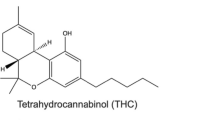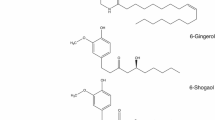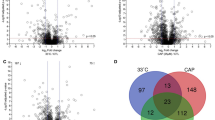Abstract
Cannflavins, flavonoids abundantly present in Cannabis sativa, possess a distinct chemical structure comprising a vanillyl group. Notably, the capsaicin structure also contains a vanillyl group, which is considered essential for interacting with the vanilloid receptor. The vanilloid receptor plays a crucial role in the perception of pain, heat, and inflammation and mediates the analgesic effects of capsaicin. Therefore, we postulated that prolonged exposure to cannflavin A (Can A) and cannflavin B (Can B) would provoke vanilloid receptor desensitization and hinder nocifensive responses to noxious thermal stimuli. C. elegans wild-type (N2) and mutants were exposed to Can A and Can B solutions for 60 min and then aliquoted on Petri dishes divided into quadrants for thermal stimulation. We then determined the thermal avoidance index for each C. elegans experimental group. Proteomics was performed to identify proteins and pathways associated with Can A or B treatment. Prolonged exposure to Can A and Can B hindered heat avoidance (32–35 °C) in C. elegans. No antinociceptive effect was observed 6 h post Can A or B exposure. Proteomics and Reactome pathway enrichment analyses identified hierarchical differences between Can A- and B-treated nematodes. However, both treatments were related to eukaryotic translation initiation (R-CEL-72613) and metabolic processes strongly associated with pain development. Our study aids in characterizing the pharmacological activity of cannflavins isolated from Cannabis sativa and outlines a possible application as pain therapy.








Similar content being viewed by others
Data availability
Data supporting the findings of this study are available from the corresponding author upon request.
References
Abbas MA (2020) Modulation of TRPV1 channel function by natural products in the treatment of pain. Chem-biol Interact 330:109178. https://doi.org/10.1016/j.cbi.2020.109178
Amin MR, Ali DW (2019) Pharmacology of medical cannabis. Adv Exp Med Biol 1162:151–165. https://doi.org/10.1007/978-3-030-21737-2_8
Anand P, Bley K (2011) Topical capsaicin for pain management: therapeutic potential and mechanisms of action of the new high-concentration capsaicin 8% patch. Br J Anaesth 107:490–502. https://doi.org/10.1093/bja/aer260
Baratta F, Pignata I, Enri LR, Brusa P (2022) Cannabis for medical use: analysis of recent clinical trials in view of current legislation. Front Pharmacol 13:888903. https://doi.org/10.3389/fphar.2022.888903
Barrett ML, Scutt AM, Evans FJ (1986) Cannflavin A and B, prenylated flavones from Cannabis sativa L. Experientia 42:452–453. https://doi.org/10.1007/bf02118655
Bautista JL, Yu S, Tian L (2021) Flavonoids in Cannabis sativa: biosynthesis, bioactivities, and biotechnology. ACS Omega 6:5119–5123. https://doi.org/10.1021/acsomega.1c00318
Beaudry F, Ross A, Lema PP, Vachon P (2010) Pharmacokinetics of vanillin and its effects on mechanical hypersensitivity in a rat model of neuropathic pain. Phytother Res 24:525–530. https://doi.org/10.1002/ptr.2975
Bindea G, Mlecnik B, Hackl H et al (2009) ClueGO: a Cytoscape plug-in to decipher functionally grouped gene ontology and pathway annotation networks. Bioinformatics 25:1091–1093. https://doi.org/10.1093/bioinformatics/btp101
Bölcskei K, Tékus V, Dézsi L et al (2010) Antinociceptive desensitizing actions of TRPV1 receptor agonists capsaicin, resiniferatoxin and N-oleoyldopamine as measured by determination of the noxious heat and cold thresholds in the rat. Eur J Pain (London, England) 14:480–486. https://doi.org/10.1016/j.ejpain.2009.08.005
Brenner S (1974) The genetics of Caenorhabditis elegans. Genetics 77:71–94. https://doi.org/10.1093/genetics/77.1.71
Caterina MJ (2000) Impaired nociception and pain sensation in mice lacking the capsaicin receptor. Science 288:306–313. https://doi.org/10.1126/science.288.5464.306
Cohen SP, Vase L, Hooten WM (2021) Chronic pain: an update on burden, best practices, and new advances. Lancet 397:2082–2097. https://doi.org/10.1016/s0140-6736(21)00393-7
Dickenson A (1995) Spinal cord pharmacology of pain. Br J Anaesth 75(2):193–200. https://doi.org/10.1093/bja/75.2.193
Drew LJ, Wood JN (2005) Worm sensation! Mol Pain 1:8. https://doi.org/10.1186/1744-8069-1-8
Eggers C, Fujitani M, Kato R, Smid S (2019) Novel cannabis flavonoid, cannflavin A displays both a hormetic and neuroprotective profile against amyloid β-mediated neurotoxicity in PC12 cells: Comparison with geranylated flavonoids, mimulone and diplacone. Biochem Pharmacol 169:113609. https://doi.org/10.1016/j.bcp.2019.08.011
Erridge S, Mangal N, Salazar O et al (2020) Cannflavins - From plant to patient: A sco** review. Fitoterapia 146:104712. https://doi.org/10.1016/j.fitote.2020.104712
Ezak MJ, Ferkey DM (2011) A functional nuclear localization sequence in the C. elegans TRPV channel OCR-2. Plos One 6:e25047. https://doi.org/10.1371/journal.pone.0025047
Ferland CE, Beaudry F, Vachon P (2012) Antinociceptive effects of eugenol evaluated in a monoiodoacetate-induced osteoarthritis rat model. Phytother Res 26:1278–1285. https://doi.org/10.1002/ptr.3725
Finnerup NB (2019) Nonnarcotic methods of pain management. New Engl J Med 380:2440–2448. https://doi.org/10.1056/nejmra1807061
Formolo DA, Cheng T, Yu J et al (2022) Central adiponectin signaling – A metabolic regulator in support of brain plasticity. Adv Neurol 8:79–96. https://doi.org/10.3233/bpl-220138
Giaccari LG, Aurilio C, Coppolino F et al (2021) Capsaicin 8% patch and chronic postsurgical neuropathic pain. J Pers Medicine 11:960. https://doi.org/10.3390/jpm11100960
Glauser DA, Chen WC, Agin R et al (2011) Heat avoidance is regulated by transient receptor potential (TRP) channels and a neuropeptide signaling pathway in Caenorhabditis elegans. Genetics 188:91–103. https://doi.org/10.1534/genetics.111.127100
Guenette SA, Beaudry F, Marier JF, Vachon P (2006) Pharmacokinetics and anesthetic activity of eugenol in male Sprague-Dawley rats. J Vet Pharmacol Ther 29:265–270. https://doi.org/10.1111/j.1365-2885.2006.00740.x
Guénette SA, Hélie P, Beaudry F, Vachon P (2007a) Eugenol for anesthesia of African clawed frogs (Xenopus laevis). Vet Anaesth Analg 34:164–170. https://doi.org/10.1111/j.1467-2995.2006.00316.x
Guénette SA, Ross A, Marier J-F et al (2007b) Pharmacokinetics of eugenol and its effects on thermal hypersensitivity in rats. Eur J Pharmacol 562:60–67. https://doi.org/10.1016/j.ejphar.2007.01.044
Gupta N, Pevzner PA (2009) False discovery rates of protein identifications: A strike against the two-peptide rule. J Proteome Res 8:4173–4181. https://doi.org/10.1021/pr9004794
Hui K, Liu B, Qin F (2003) Capsaicin activation of the pain receptor, VR1: multiple open states from both partial and full finding. Biophys J 84:2957–2968. https://doi.org/10.1016/s0006-3495(03)70022-8
Iftinca M, Defaye M, Altier C (2021) TRPV1-targeted drugs in development for human pain conditions. Drugs 81:7–27. https://doi.org/10.1007/s40265-020-01429-2
Jancsó G, Dux M, Oszlács O, Sántha P (2008) Activation of the transient receptor potential vanilloid-1 (TRPV1) channel opens the gate for pain relief. Brit J Pharmacol 155:1139–1141. https://doi.org/10.1038/bjp.2008.375
Jordt S, Julius D (2002) Molecular basis for species-specific sensitivity to “hot” chili peppers. Cell 108:421–430
Kahn-Kirby AH, Bargmann CI (2006) TRP channels in C. elegans. Annu Rev Physiol 68:719–736. https://doi.org/10.1146/annurev.physiol.68.040204.100715
Khoutorsky A, Price TJ (2018) Translational control mechanisms in persistent pain. Trends Neurosci 41:100–114. https://doi.org/10.1016/j.tins.2017.11.006
Knotkova H, Hamani C, Sivanesan E et al (2021) Neuromodulation for chronic pain. Lancet 397:2111–2124. https://doi.org/10.1016/s0140-6736(21)00794-7
Lee MC, Ploner M, Wiech K et al (2013) Amygdala activity contributes to the dissociative effect of cannabis on pain perception. Pain 154:124–134. https://doi.org/10.1016/j.pain.2012.09.017
Liedtke WB, Heller S, Sze JY (2007) The TRPV Channel in C. elegans Serotonergic Neurons. CRC Press
Lionnet L, Beaudry F, Vachon P (2010) Intrathecal eugenol administration alleviates neuropathic pain in male Sprague-Dawley rats. Phytother Res 24:1645–1653. https://doi.org/10.1002/ptr.3174
Margie O, Palmer C, Chin-Sang I (2013) C. elegans</em> Chemotaxis Assay. Journal of visualized experiments : JoVE 1–6. https://doi.org/10.3791/50069
Markaki M, Tavernarakis N (2020) Caenorhabditis elegans as a model system for human diseases. Current Opin Biotechnol 63:118–125. https://doi.org/10.1016/j.copbio.2019.12.011
Martins D, Silva M, Tavares I (2017) TRPV1 in pain control from the brain. Oncotarget 8:16101–16102. https://doi.org/10.18632/oncotarget.13316
Matias I, Buosi AS, Gomes FCA (2016) Functions of flavonoids in the central nervous system: astrocytes as targets for natural compounds. Neurochem Int 95:85–91. https://doi.org/10.1016/j.neuint.2016.01.009
Mills SEE, Nicolson KP, Smith BH (2019) Chronic pain: a review of its epidemiology and associated factors in population-based studies. Brit J Anaesth 123:e273–e283. https://doi.org/10.1016/j.bja.2019.03.023
Montell C (2003) The venerable inveterate invertebrate TRP channels. Cell Calcium 33:409–417
Moran MM (2017) TRP channels as potential drug targets. Annu Rev Pharmacol Toxicol 58:309–330. https://doi.org/10.1146/annurev-pharmtox-010617-052832
Mori I (1999) Genetics of chemotaxis and thermotaxis in the nematode Caenorhabditis elegans. Ann Rev Genet 33:399–422. https://doi.org/10.1146/annurev.genet.33.1.399
Nkambeu B, Salem JB, Beaudry F (2021) Eugenol and other vanilloids hamper Caenorhabditis elegans response to noxious heat. Neurochem Res 46:252–264. https://doi.org/10.1007/s11064-020-03159-z
Nkambeu B, Salem JB, Beaudry F (2020) Capsaicin and its analogues impede nocifensive response of Caenorhabditis elegans to noxious heat. Neurochem Res 45:1851–1859. https://doi.org/10.1007/s11064-020-03049-4
Nkambeu B, Salem JB, Beaudry F (2023) Antinociceptive activity of vanilloids in Caenorhabditis elegans is mediated by the desensitization of the TRPV channel OCR-2 and specific signal transduction pathways. Neurochem Res 48:1900–1911. https://doi.org/10.1007/s11064-023-03876-1
Nkambeu B, Salem JB, Leonelli S et al (2018) EGL-3 and EGL-21 are required to trigger nocifensive response of Caenorhabditis elegans to noxious heat. Neuropeptides 73:41–48. https://doi.org/10.1016/j.npep.2018.11.002
Ohnishi K, Saito S, Miura T et al (2020) OSM-9 and OCR-2 TRPV channels are accessorial warm receptors in Caenorhabditis elegans temperature acclimatisation. Sci Rep 10:18566. https://doi.org/10.1038/s41598-020-75302-3
Ortiz YT, McMahon LR, Wilkerson JL (2022) Medicinal cannabis and central nervous system disorders. Front Pharmacol 13:881810. https://doi.org/10.3389/fphar.2022.881810
Pauli CS, Conroy M, Heuvel BDV, Park S-H (2020) Cannabidiol drugs clinical trial outcomes and adverse effects. Front Pharmacol 11:63. https://doi.org/10.3389/fphar.2020.00063
Pinho-Ribeiro FA, Verri WA, Chiu IM (2017) Nociceptor sensory neuron–immune interactions in pain and inflammation. Trends Immunol 38:5–19. https://doi.org/10.1016/j.it.2016.10.001
Privitera R, Birch R, Sinisi M et al (2017) Capsaicin 8% patch treatment for amputation stump and phantom limb pain: a clinical and functional MRI study. J Pain Res 10:1623–1634. https://doi.org/10.2147/jpr.s140925
Procaccia S, Lewitus GM, Feder CL et al (2022) Cannabis for medical use: versatile plant rather than a single drug. Front Pharmacol 13:894960. https://doi.org/10.3389/fphar.2022.894960
Radwan MM, ElSohly MA, Slade D et al (2008) Non-cannabinoid constituents from a high potency Cannabis sativa variety. Phytochemistry 69:2627–2633. https://doi.org/10.1016/j.phytochem.2008.07.010
Rea KA, Casaretto JA, Al-Abdul-Wahid MS et al (2019) Biosynthesis of cannflavins A and B from Cannabis sativa L. Phytochemistry 164:162–171. https://doi.org/10.1016/j.phytochem.2019.05.009
Romero-Sandoval EA, Fincham JE, Kolano AL et al (2018) Cannabis for chronic pain: Challenges and considerations. Pharmacother J Hum Pharmacol Drug Ther 38:651–662. https://doi.org/10.1002/phar.2115
Rosser BA, Fisher E, Eccleston C et al (2021) Psychological therapies delivered remotely for the management of chronic pain (excluding headache) in adults. Cochrane Database Syst Rev 8(8):CD007407. https://doi.org/10.1002/14651858.cd0138635
Salem JB, Nkambeu B, Arvanitis DN, Beaudry F (2022) Resiniferatoxin hampers the nocifensive response of Caenorhabditis elegans to noxious heat, and pathway analysis revealed that the Wnt signaling pathway is involved. Neurochem Res 47:622–633. https://doi.org/10.1007/s11064-021-03471-2
Satheesh NJ, Uehara Y, Fedotova J et al (2016) TRPV currents and their role in the nociception and neuroplasticity. Neuropeptides. https://doi.org/10.1016/j.npep.2016.01.003
Schafer WR (2006) Proprioception: a channel for body sense in the worm. Curr Biol 16:R509–R511. https://doi.org/10.1016/j.cub.2006.06.012
Shannon P, Markiel A, Ozier O et al (2003) Cytoscape: a software environment for integrated models of biomolecular interaction networks. Genome Res 13:2498–2504. https://doi.org/10.1101/gr.1239303
Sibille KT, Bartsch F, Reddy D et al (2016) Increasing neuroplasticity to bolster chronic pain treatment: a role for intermittent fasting and glucose administration? J Pain 17:275–281. https://doi.org/10.1016/j.jpain.2015.11.002
Sultana A, Singla RK, He X et al (2021) Topical capsaicin for the treatment of neuropathic pain. Curr Drug Metab 22:198–207. https://doi.org/10.2174/1389200221999201116143701
Szolcsányi J (2014) Capsaicin as a therapeutic molecule. Prog Drug Res Fortschritte Der Arzneimittelforschung Progrès Des Recherches Pharm 68:1–37. https://doi.org/10.1007/978-3-0348-0828-6_1
Tan P-H, Ji J, Yeh C-C, Ji R-R (2021) Interferons in pain and infections: emerging roles in neuro-immune and neuro-glial interactions. Front Immunol 12:783725. https://doi.org/10.3389/fimmu.2021.783725
Tobin D, Madsen D, Kahn-Kirby A et al (2002) Combinatorial expression of TRPV channel proteins defines their sensory functions and subcellular localization in C. elegans neurons. Neuron 35:307–318
Tominaga M, Julius D (2000) Capsaicin receptor in the pain pathway. Jpn J Pharmacol 83:20–24. https://doi.org/10.1254/jjp.83.20
Uttam S, Wong C, Price TJ, Khoutorsky A (2018) eIF4E-dependent translational control: a central mechanism for regulation of pain plasticity. Front Genet 9:470. https://doi.org/10.3389/fgene.2018.00470
Vita SD, Finamore C, Chini MG et al (2022) Phytochemical analysis of the methanolic extract and essential oil from leaves of industrial hemp Futura 75 cultivar: isolation of a new cannabinoid derivative and biological profile using computational approaches. Plants 11:1671. https://doi.org/10.3390/plants11131671
Werz O, Seegers J, Schaible AM et al (2014) Cannflavins from hemp sprouts, a novel cannabinoid-free hemp food product, target microsomal prostaglandin E2 synthase-1 and 5-lipoxygenase. PharmaNutrition 2:53–60. https://doi.org/10.1016/j.phanu.2014.05.001
Wittenburg N, Baumeister R (1999) Thermal avoidance in Caenorhabditis elegans: an approach to the study of nociception. Proc Natl Acad Sci U S A 96:10477–10482
Wortley MA, Birrell MA, Belvisi MG (2017) Drugs affecting TRP channels. Handb Exp Pharmacol 237:213–241. https://doi.org/10.1007/164_2016_63
**ao R, Xu XZS (2011) C. elegans TRP channels. Adv Exp Med Biol 704:323–339. https://doi.org/10.1007/978-94-007-0265-3_18
Yang BH, Piao ZG, Kim Y-B et al (2016) Activation of vanilloid receptor 1 (VR1) by eugenol. J Dent Res 82:781–785. https://doi.org/10.1177/154405910308201004
Yoshimura M, Yonehara N (2001) Influence of capsaicin cream in rats with peripheral neuropathy. Pharmacol Res 44:105–111. https://doi.org/10.1006/phrs.2001.0830S1043-6618(01)90830-8[pii]
Zhou WBS, Shi XQ, Liu Y et al (2023) Unbiased proteomic analysis detects painful systemic inflammatory profile in the serum of nerve-injured mice. Pain 164:e77–e90. https://doi.org/10.1097/j.pain.0000000000002695
Zhou Y, Zhou B, Pache L et al (2019) Metascape provides a biologist-oriented resource for the analysis of systems-level datasets. Nat Commun 10:1523. https://doi.org/10.1038/s41467-019-09234-6
Funding
M. Lahaise received a National Sciences and Engineering Research Council of Canada Undergraduate Student Research Award. This project was funded by the National Sciences and Engineering Research Council of Canada (F. Beaudry Discovery Grant No. RGPIN-2020–05228). The laboratory equipment was funded by the Canadian Foundation for Innovation (CFI), the Fonds de Recherche du Québec (FRQ), and the Government of Quebec (F. Beaudry CFI John R. Evans Leaders grant nos. 36706 and 42043). F. Beaudry holds the Canada Research Chair in Metrology of Bioactive Molecules and Target Discovery (grant no. CRC-2021–00160). This research was partially supported by funding from the Canada Research Chairs Program.
Author information
Authors and Affiliations
Contributions
M. Lahaise, F. Boujenoui, and F. Beaudry conceived and designed this study. M. Lahaise and F. Boujenoui conducted the experiments. M. Lahaise, F. Boujenoui, and F. Beaudry conducted data analysis and wrote the manuscript. All the authors have read and approved the final manuscript. All authors declare that all data were generated in-house and that no paper mill was used.
Corresponding author
Ethics declarations
Ethical approval
Not applicable.
Competing interests
The authors declare no competing interests.
Additional information
Publisher's note
Springer Nature remains neutral with regard to jurisdictional claims in published maps and institutional affiliations.
Supplementary information
Below is the link to the electronic supplementary material.
Rights and permissions
Springer Nature or its licensor (e.g. a society or other partner) holds exclusive rights to this article under a publishing agreement with the author(s) or other rightsholder(s); author self-archiving of the accepted manuscript version of this article is solely governed by the terms of such publishing agreement and applicable law.
About this article
Cite this article
Lahaise, M., Boujenoui, F. & Beaudry, F. Cannflavins isolated from Cannabis sativa impede Caenorhabditis elegans response to noxious heat. Naunyn-Schmiedeberg's Arch Pharmacol 397, 535–548 (2024). https://doi.org/10.1007/s00210-023-02621-3
Received:
Accepted:
Published:
Issue Date:
DOI: https://doi.org/10.1007/s00210-023-02621-3




